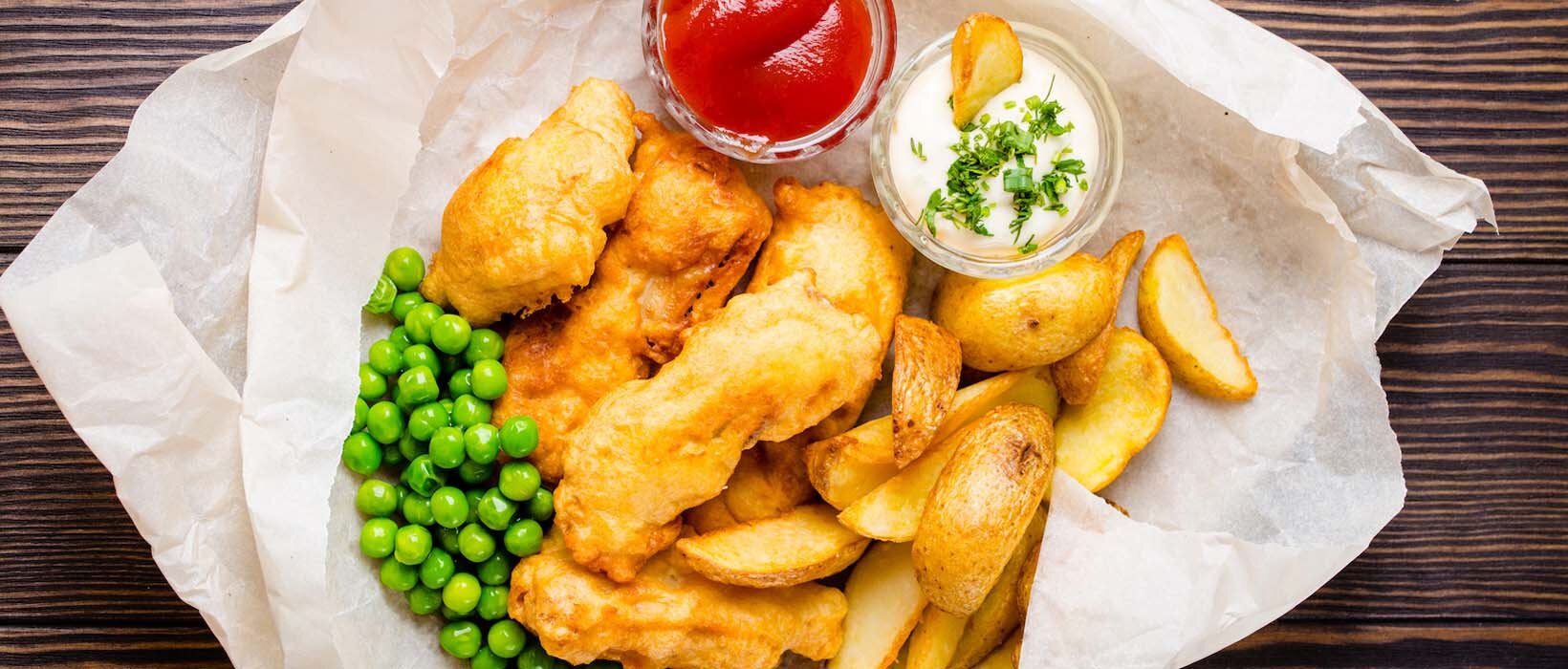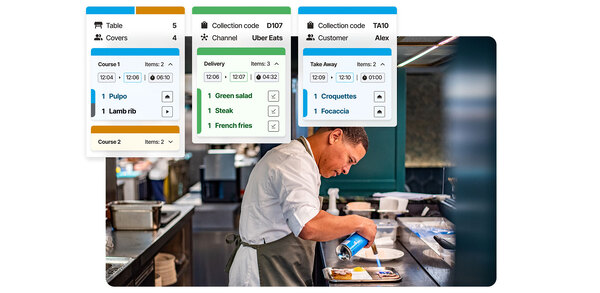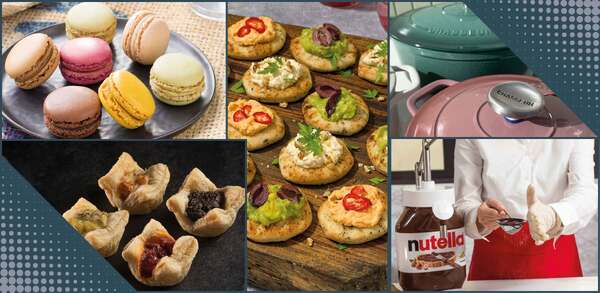Chip, chip hooray: how to fry up the perfect fish and chips
If you want to fry up the very best fish and chips for your customers, ask chef Nathan Outlaw how he does it. Lisa Jenkins gets the lowdown as well as tips on perfect potatoes and super side dishes.
Chef Nathan Outlaw, owner of the Michelin-starred Outlaw’s New Road and Outlaw’s Fish Kitchen in Port Isaac, Cornwall, has earned his stripes when it comes to cooking fish and chips.
“I always recommend trying a different species of fish to the usual cod. My personal favourite is the larger grey gurnard,” he says. “Gurnard has a dense structure to the fillet, therefore it takes a bit longer for the heat to pass through and so you don’t over-cook the fish before you get the perfect crispy batter on the outside. I also find gurnard has more flavour and character – almost a sweet shellfish flavour.”
With regards to the batter, he adds: “Over many years of eating, cooking and studying fish and chips, I have tried lots of batters. The go-to for many posh fish and chips is the beer batter, but for me, I find it detracts from the fish and therefore you could be frying any species in it and you wouldn’t taste the difference.
“My personal favourite is a batter made with gluten-free self-raising flour and sparkling cider. The batter is very crispy and light and, done correctly, it has no soggy bits and will stay crisp for some time. The bonus of being gluten-free helps a lot with diners with dietary challenges.
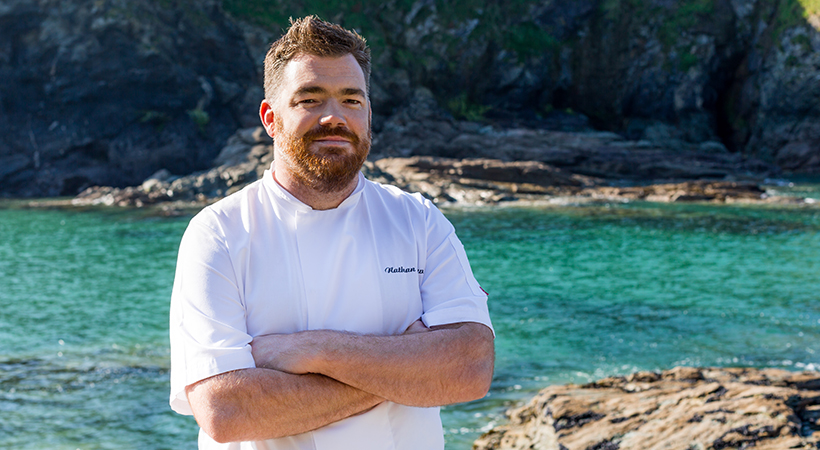
“If I really want to impress, I chop a mixture of parsley, tarragon, chives and chervil and mix it with lemon zest. I sprinkle this over the fish, pat it gently to the fillet so that it sticks, and then dip the whole thing in the batter before frying. The herbs and lemon zest give the fish a little bit of extra something that makes the fish taste amazing.”
Simon Hulstone, chef-patron of the Michelin-starred Elephant in Torquay and Norwegian Seafood’s Seafood from Norway ambassador, believes that frozen-at-sea produce should be on every savvy chef’s radar to ease mounting pressures in the kitchen.
“To maintain quality, frozen-at-sea Norwegian cod and haddock is caught, processed, filleted and frozen to below -20ºC within two to five hours. This state-of-the-art blast-freezing process locks in optimal freshness, nutrients, and taste without compromising on quality.
“Additionally, Norway has been exporting sustainably sourced frozen-at-sea cod and haddock to the UK for over 70 years and is committed to this ongoing trade throughout lockdown and beyond.”
Joel Carr, development chef at Young’s Foodservice, is looking forward to tempting customers back to enjoy their favourite dishes at pubs and restaurants once again.
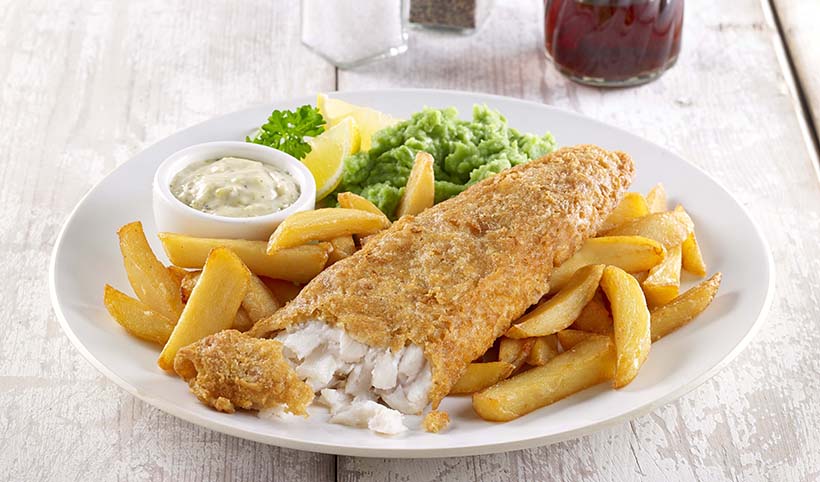
“It’s important to achieve the right balance of tradition and innovation on menus to impress all customers,” he says. “Whether it’s as simple as serving with an on-trend katsu curry sauce, adding mint to mushy peas, or even offering chips that are salted with seaweed, there are many ways in which caterers can update this timeless dish.
“Young’s range of Chip Shop fillets is the easiest way to deliver the taste of the nation’s favourite chippy. The Chip Shop Battered Fillets are coated in Young’s signature Chip Shop bubbly batter and are a quick and convenient alternative to battering in-house.
“It is also important to consider serving different sizes and varieties to ensure you’re appealing to all customers. Some customers might want a light lunchtime bite instead of a large and filling portion. As well as being available in a selection of species (wild Alaska pollock, haddock or cod), our MSC-certified Chip Shop Battered Fillets are available in small, medium and large.”
Chip and change
“Chips are again a personal taste, but for me it’s about keeping it simple,” says Outlaw. “Maris Piper potatoes at the right time of year are bang on, but there are great potatoes that have also been developed and grown especially, like Chippie’s Choice.
“I always bring my peeled and pre-cut spuds to the boil in salted water and then simmer them until they start to break up at the edges. I then drain and leave them on a tray in the fridge for at least six hours or overnight. To cook, I set my fryer to 150ºC and cook the chips for 10 minutes, drain them, and again spread them out on a tray lined with greaseproof paper and leave them to cool.
“For the final fry, I turn the fryer up to 190ºC and cook the chips until they are crisp and golden. And I season with fine sea salt because larger salt flakes just bounce off.”
Mohammed Essa, commercial director, Aviko UK & Ireland, adds that with chefs putting more focus on perfecting their batter and dishing up homemade mushy peas and tartare sauce, it’s increasingly important for operators to get their chip offering right.
“Using longer chips is a great way to boost fish and chip profits. Not only do they provide greater plate-fill with the visual appeal of overflowing chips, but they can also make every case go further. Aviko’s 9.5mm Super Longs typically give kitchens 19 extra portions per case compared to standard chips, providing a saving of £7,800 a year.”
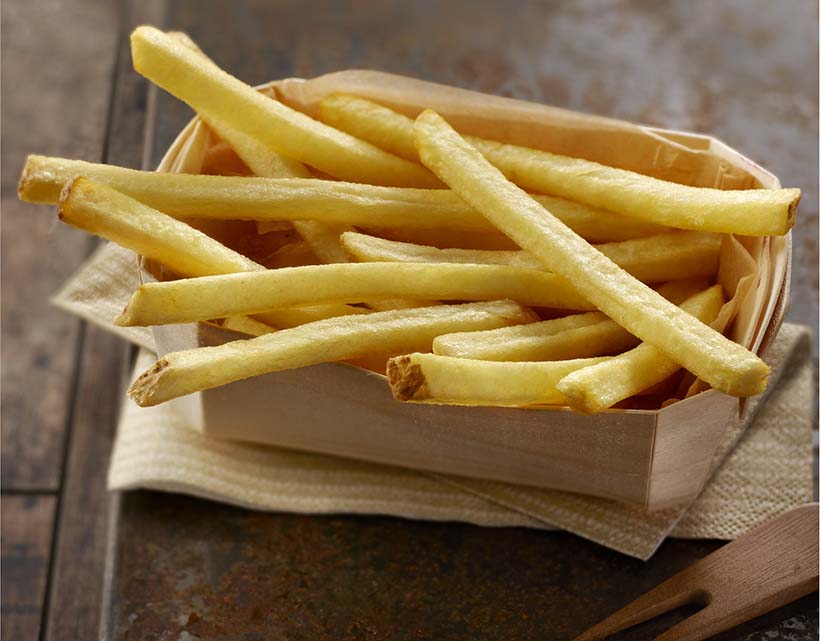
Aviko offers a range of chilled and frozen potato products, such as hash browns and hash brown bites, as well as premium fries, mash and roasties.
Lamb Weston’s the Dukes of Chippingdom chips are irregularly thick-cut to appear homemade. The chips are non-coated and have feathered golden edges and are fluffy on the inside. They are cut from 100% British potatoes and endorsed by the Craft Guild of Chefs.
Lamb Weston reveals that in the first lockdown sales figures for fish and chips more than doubled, with a 208% increase in orders by May, topping the takeaway list. By September, fish and chip sales had soared 22% in 2020.
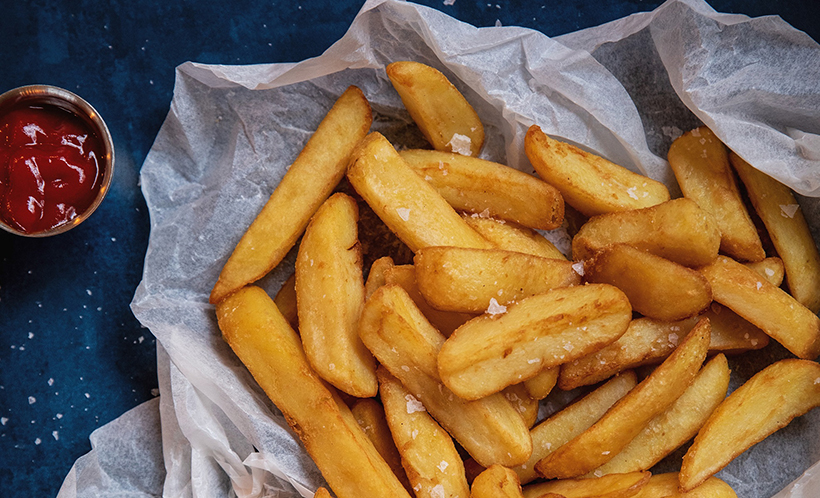
Under wraps
Ross Crook, corporate chef at Rational UK, says there are plenty of ways to make your fish and chips stand out from the crowd. “For example, the humble chip can be double- or even triple-cooked, while traditional sides like mushy peas could be substituted for refried or rich, smokey chipotle beans. Tartare sauce can be spiced up with the addition of a pinch of chilli and paprika.
“Even bigger changes can be made by switching from the traditional methods of cooking fish and chips. Many Rational customers are using the iVario Pro multifunctional cooking system instead of deep-fat fryers, which can take the pressure off chip preparation and provide speed and efficiency, while the iCombi Pro combi-steamer can be used for healthier alternatives of preparing fish, like steaming and grilling.”
Sezer Ozkul, chief operating officer, JJ Foodservice, says: “With ongoing restrictions on eating out, more restaurants and pubs have converted their offer to takeaway, and so it’s crucial to have the right packaging. After all, no one wants soggy batter.
“Our packaging range includes compostable drink cups, straws and food waste liners, and compostable and biodegradable cutlery and boxes. There is also a great appetite from consumers to use less plastic and more sustainable alternatives, so make sure you highlight your eco-credentials on your menu.”
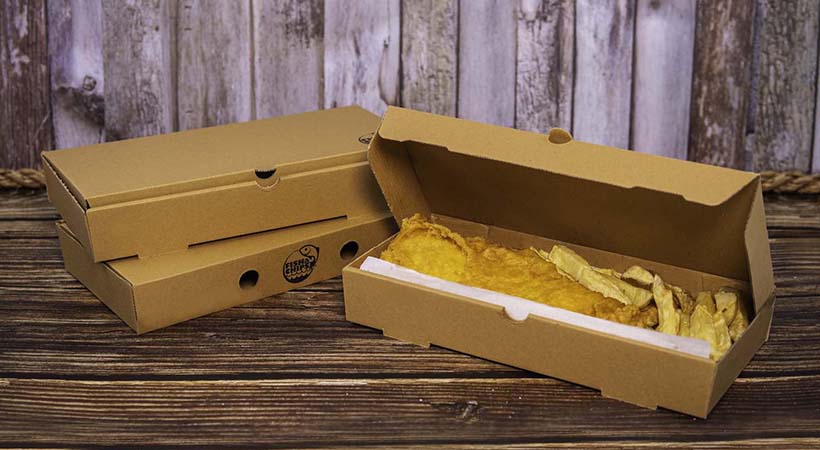
John Young, sales and marketing director at KeCo Foodservice Packaging, agrees that using premium quality disposables is essential in ensuring acceptable delivery of the order, which is a continuation of the outlet’s reputation. “Substantial, premium quality packaging choices are necessary to present takeaways in a practical way that is fit for purpose – to keep items hot without them going soggy; to prevent grease from coating whatever the disposable encounters; and to offer protection while the order is being carried or packed for consumption later.
KeCo also offers sturdy disposables made from bagasse, a fibrous waste material from sugar cane production, which is biodegradable and compostable.
“Packaging is a truly fantastic marketing tool,” says Young. “A bespoke design for your disposables, created with a manufacturer, will set you apart. And augmented reality and QR codes can create bespoke, impactful packaging which captivates customers. It’s a great way of conveying specific messages, from targeted promotions to information about the sourcing and provenance of ingredients.”
A bit on the side
Outlaw says mushy peas can be considered a bit boring: “This is often down to the seasoning – if you don’t season them correctly, overdo it with the bicarbonate or don’t add enough malt vinegar. I usually add some fresh or frozen peas to my mushy peas along with some chopped mint, oregano and a knob of salted butter.”
As for tartare sauce, Outlaw’s favourite accompaniment, he always starts with English mustard mayonnaise, a great base for adding ingredients. “I use chopped gherkins, capers, jalapeños and shallots, lemon zest, chervil, tarragon, parsley and chives. I always go 50/50 on the mayonnaise to other ingredients, which for me gives the perfect balance.”
Bryan Carroll, Sarson’s sales and marketing director, says: “The UK food delivery market is currently booming, hitting an estimated £7.1b at the end of 2020, with fish and chips second only to pizza as the most-ordered dish, providing a massive profit opportunity for operators who serve the British staple.
“Whether they’re ordering from their local chippie, a gastropub or a high-end restaurant, consumers care more than ever about the quality and provenance of the food they eat out of home and it’s no different when it comes to condiments.
“Sarson’s recent research found 90% of diners prefer to see condiment brands they know and trust when eating out.”
The challenge operators now face, adds Carroll, is meeting the demand in as safe and convenient a way as possible while still delivering a top-quality product. Sarson’s new hygienic and convenient 7g sachets are designed especially with delivery and takeaway in mind.
British craft condiment brand Sauce Shop recently launched its first unsweetened tomato ketchup, created by husband-and-wife team James and Pam Digva. The ketchup is described as an umami-rich blend of ripened tomatoes, onion, garlic and a splash of white grape vinegar, rounded off with nutmeg and allspice.
Oil you need
Olivia Kitching, brand manager for Prep high-performance frying oils from AAK Foodservice, says when it comes to serving up fish and chips, choosing the right frying oil is crucial:
- An oil with a longer fry life gives you the best overall value. It will save time and effort in cleaning and maintenance and help to prolong the life of your fryer. Most importantly, it means your fish and chips look and taste as they ought to.
- Consider how much and how often you fry, and the kinds of foods you will be cooking. Someone who fries chips twice a week needs a different kind of oil from a caterer cooking fish and chips around the clock.
Oil management
- Remove food particles as you cook.
- Keep baskets out of the oil and dust covers on when not in use to minimise oxidation.
- Avoid frying wet foods and remove any visible ice from frozen foods before cooking.
- Ensure your fryer is completely dry before loading new oil.
- Filter oil daily at a temperature of 40°C.
All at sea
The recent announcement of a £23m fund available to support exporters in the fishing industry that have experienced losses after the EU-UK Trade and Co-operation Agreement, signed on 30 December, received a lukewarm response by the hundreds of fishermen and women in the UK.
Victoria Prentis, parliamentary under-secretary of state for farming, fisheries and food, who announced the fund on 20 January, said it would also be available to fishermen who had experienced losses due to the Covid-19 pandemic.
Making the announcement at the recent Westminster Food & Nutrition Forum policy conference, she accepted that although the UK “was already an independent state, that the six to 12 miles compromise [where fishing vessels from the EU have access to UK waters], would need to be looked at again in five years’ time, [and that she hoped] the next five years would act as an adjustment period”.
Jim Portus, chief executive of the South Western Fish Producers Organisation, who also spoke at the forum, told The Caterer: “The bottom line is that I remain optimistic. The industry is made up of many different parts, but the catching sector is the one that actually produces the fish that is then converted into money by the fish merchants. Money that is then used to repair the boats, pay for the upkeep of the fish market and pay for onward transportation costs.
“Since the referendum, some people have been minimising the size of the fishing industry, but at the end of the day it’s a lot more than just the fishermen and women; it’s their families and the communities and all the associated businesses. There are four or five associated onshore jobs for every one job at sea.
“While we have become used to the export market, the other side of that coin is that in the UK we also rely on our imports from the far east: king prawns, tilapia, Pacific salmon, sardines and anchovies. There is a huge amount of product imported into the UK and for us to get the best out of Brexit we must encourage a change of attitude within our consumers.
“From March to October last year, domestic consumption of UK-caught fish increased by more than 10% and that is an amazing stat. It shows that the UK consumer can get behind the UK fishing market. I hope we continue to see the direct [consumer] sales at UK ports and fish markets. If the 66 million-plus consumers in the UK ate the two recommended portions of fish per week, we wouldn’t even have enough to go around.”
Suppliers
Aviko www.aviko.co.uk
JJ Foodservice www.jjfoodservice.com
KeCo Foodservice Packaging www.kecofsp.com
Lamb Weston www.lambweston.eu/uk
Norwegian Seafood www.seafoodfromnorway.co.uk
Prep www.prepoils.co.uk
Rational www.rational-online.com
Sarson’s www.switchtosarsons.co.uk
Sauce Shop www.sauceshop.co
Young’s Foodservice www.youngsfoodservice.co.uk


